The Other Side of Interracial Marriage: What’s it Like to be Married to an Indian
- Sure, there are amusing cultural differences, but most spouses with the Indian “better half” vouch for a smooth sailing of their wedded lives. Mild spices included.
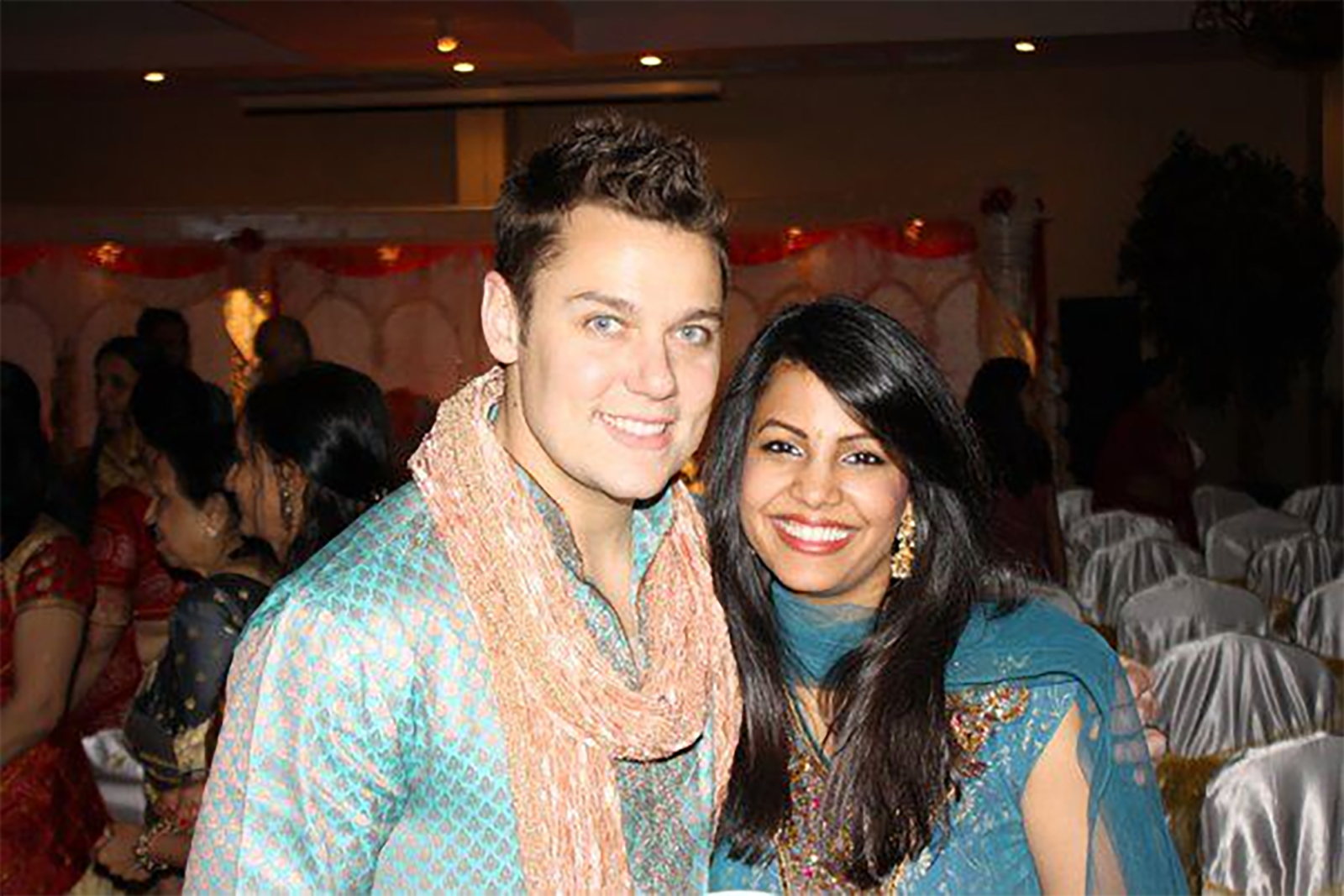
Interracial marriages are becoming more commonplace today with families blending cultures, traditions and lives. However, in the South Asian immigrant community, acceptance of multiracial relationships can sometimes be fraught with challenges. The warning that many of us may have heard growing up — ‘don’t marry a BMW’ (Black, Muslim or White). But if you do, it’s preferable to marry a White man/woman. The South Asian color hierarchy is not something we can wish away.
While curiosity about interracial marriages is ever present on all sides, we seldom hear the perspective of the “other,” the spouse who is not Indian. How do they cope with a spouse whose Indian culture can sometimes be snobbish, insular, at times overbearing and often judgmental. A random sampling of views of Americans with Indian spouses, however, reveals a surprising smooth sailing of their wedded lives.
Given the conservative Indian society that frowns on interracial marriages, one expects the road to eternal happiness to be littered with tensions and missteps. Minnesotan Scott Elvin, 45, director of IT, a husband and a father disagrees. Having been married to his college sweetheart for 23 years, Scott says, “When I first started dating my wife, I would have said to keep an open mind. As I’ve grown older, I’ve come to learn that it’s the underlying values that are most important – which go even deeper than religion, race and culture.”
And even though, they didn’t meet any opposition, as his parents and those of his Bengali wife were very accepting, there were some issues that came up. But these are not the kind of issues that whip up the interest of anthropologists and sociologists. Cooks and chefs, at best. “I first visited India when I was still dating my wife,” Scott remembers. “For months before the visit I ate spicy food to try and build up a tolerance so I could impress her parents. However, ‘spicy’ in America is not nearly the same as spicy in India,” he says, remembering early days of watering eyes and burning mouth. Today, Scott loves Indian food and orders “a medium spice level” and has even tried his hand at making chicken saag and the ever-green chicken butter masala. But he loves “shahi korma the best.”
The bespectacled Scott remembers with a laugh, “I am very fond of Indian food, so my mother-in-law and I got along very well! Food smoothed it over.”
As we keep digging further, surprisingly, we find other instances of acceptance, where South Asian parents have risen to the occasion – accepting their new family member with open arms.
She Picked Me Up At the Bar
Gainesville, Georgia resident Tom Cornett, 50, a consultant who celebrated 20 years of marriage on June 16, says, “There really was no obvious challenge/opposition to our relationship.” Teasing his wife, Tom adds, “she stalked me from the moment she saw me…” to which pat came the reply… “I saved him!” Married to a Zoroashtrian (Parsi) from Mumbai, Tom clarifies that their happily ever after started by a chance meeting at a local bar called the Monkey Barrel. Unable to help himself, he jokes… “She picked me up at a bar…”
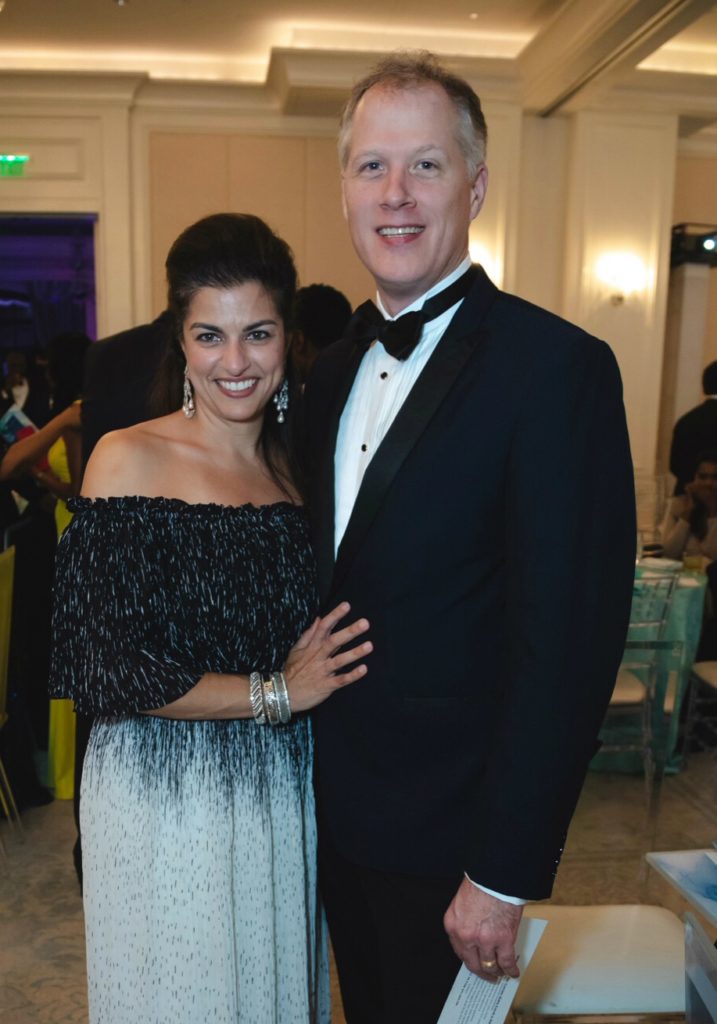
From a family of 5, growing up Episcopalian in Southern Georgia, Tom was always interested in other cultures. Apparently at 7, he had declared that he was not going to marry an American. Tom studied International Affairs in college, but points out “the strange thing was that before I met her, I’d never been outside the country.” Tom, who has now been to Indian numerous times adds, “I knew I was not just destined to living in Gainesville, Georgia.”
“My mom was the one who had been trying to set us up, as she had met Nairika through work and had no problem. There was a little of the feeling of the loss of what was, since I was the last one still standing single, so it was that feeling of ‘she will take him away…’ nothing to do with cultural differences. My dad actually knew her too. While in graduate school in Gainesville, she worked at Luna’s, a local restaurant and my dad’s main watering hole and she was bartending there. So, he was okay. Some of my extended family, when I told them, made little noise as everyone in my family is white, but that was the extent of it.”
How did he react to her family — “On the surface they were very open and welcoming. I never experienced any negativity. Maybe in the light of white privilege, maybe I didn’t even consider it, but I was intrigued by her culture, so, I probably went out of my way to not show my bad side early on,” Tom says laughing. “I was told later that Nairika’s granny had mentioned something about not only not marrying a Parsi, but not marrying an Indian, too. But both her grandmothers, who were alive at that time, came to our wedding from Mumbai and apparently after seeing me and talking to me it was okay. We got her blessings.”
“Being among my very Southern, some crazy Christian right-wing, there were issues, but that wasn’t because of her (Nairika), but more because of how they think.”
And about his own family’s reactions: “Being among my very Southern, some crazy Christian right-wing, there were issues, but that wasn’t because of her (Nairika), but more because of how they think,” Tom says.
Family is one thing, but the larger community is altogether a different kettle of fish. Particularly, the Parsi community which leans toward excommunicating and disowning women that marry outside the tight-knit community.
“Nairika was hesitant to introduce me to the larger community (Parsi) in Atlanta,” Tom says. “It was almost two years after that she took me to a function, because she wasn’t sure how they would accept me.” There was an instance he remembers vividly: They went to dinner at the home of an elder in the community (name withheld). And after a nice dinner, he casually turned to Nairika and told her if she knew that she was ‘sinning.’ When my wife pointed out that he too was married to an American, he told her it was okay since he was a man and his wife was Unitarian and had no declared religion.
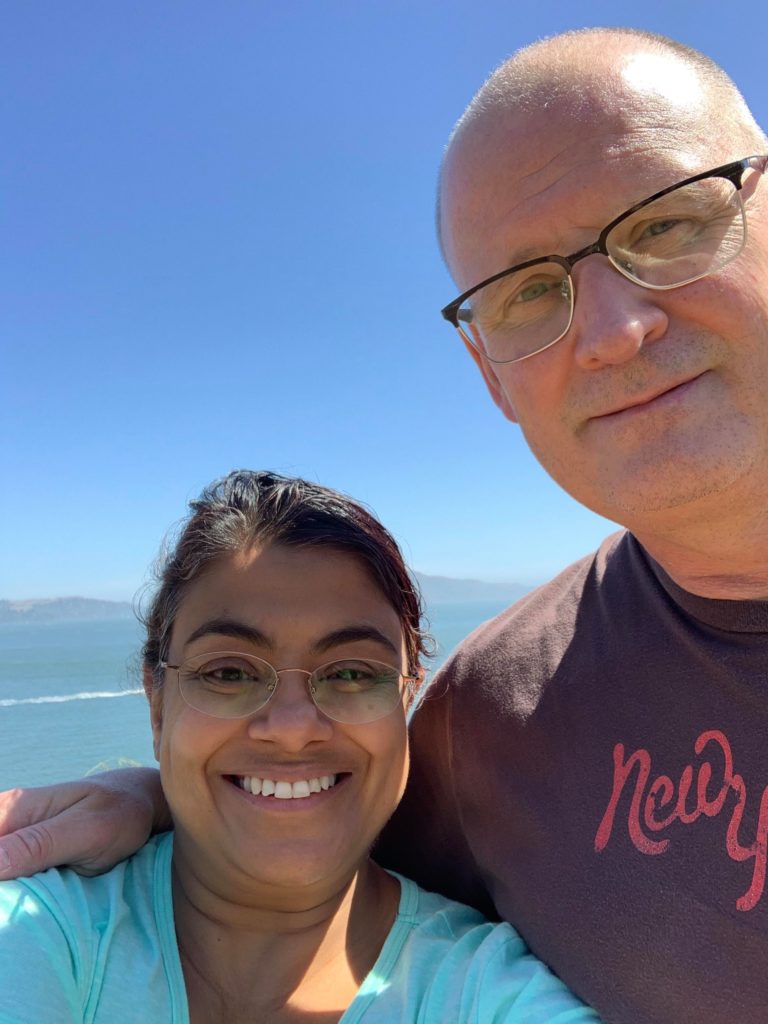
Tom, who now speaks quite a bit of Gujarati (thanks to language classes) and is affectionately called Tomla (Indianization of his name) by his friends, has since become a part of the community.
David Rake, 53, a marketing researcher, who has been married for 15 years to Srabani, who hails from Calcutta, also had an easy time traversing the cultural divide. The Atlantan says, “My family is extremely laid-back and accepting, so there were no issues or struggles at all.” David, who met his wife while both were employed as marketing researchers for Kimberly-Clark in Wisconsin adds, “There was just a lot of curiosity and interest in Srabani’s background. Growing up in Utah, I didn’t have many close Indian friends, so it was great fun to get to better understand India, and more specifically, the Bengali culture.”
Grandma, Meet My Hindu Wife
Similarly, Matt Hardy, a day trader, who has been married to his Gujarati wife Pooja for almost 12 years, says, “My dad is cool. I never thought I would have any problems with him (accepting Pooja) and I didn’t. But I remember the one thing I was nervous about was taking Pooja home to Alabama to meet my grandma. I never thought she was a racist or anything like that, but she had grown up in the Christian church and was very religious. And of course, being born and raised in India, Pooja was Hindu. So, I thought, ‘boy what am I getting into….my grandma is going to think I’m a horrible person,’” he says in imitation of Alabama drawl. “But she ended up loving her,” he adds with flourish.
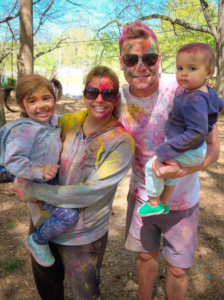
And although marrying Caucasian partners would probably raise less eyebrows within the South Asian community as it is more widely accepted, a Black spouse does not go down well. The South Asian community around the world mostly view Blacks through the white lens.
However, newly married Daryl Wilcher, 59, artist, actor, video tech, who has been married to Navami Naik for nearly 7 years says, “There were zero problems with acceptance with my family as all primary family members have passed. And I was happily relieved and touched to be quickly and affectionately embraced by my wife’s family, considering that a large portion of Indian culture still considers interracial marriages to be shameful and taboo, especially between an Indian (Maharashtrian) woman and a Black man!”
But the path to bliss is not always easy for many. Pennsylvania substitute teacher and anthropology major, Kelli and her husband Bobby Banerjee will be celebrating 20 years of marital bliss in September. “I remember Bobby asked me to marry him right before we graduated college and I remember him breaking the news to his parents and they were not happy.” However, she adds, “My parents were on the other hand, surprisingly okay with it. They had gotten to know Bobby as he would come visit them during the holidays with me and so they were okay with it.”
Raised in Southern West Virginia, a predominantly Caucasian area, and raised as a Missionary Baptist, marriage to a Bengali Hindu was a learning curve for Kelli. “I got to know his dad and brother a year before we got married, as they came and lived with us in our little apartment here in Pennsylvania. And that was an eye opener. Just a different culture. Everything was different. But that actually helped as his dad opened up a lot during that year.”
“His mom came the day before we got married and she refused to speak English in front of me. It was awkward. And then she came to live with us. That was definitely hard.”
But it was not all roses. “His mom came the day before we got married and she refused to speak English in front of me. It was awkward. And then she came to live with us. That was definitely hard.” But once parents became grandparents, the lines of communication opened up.
The years have passed and although Kelli was never quite able to learn the language, “they did not want to teach me and just wanted me to pick up on it,” with the birth of their son, the families have grown close and she has been embraced by her in-laws. They now live close by to them and “that helps with the cultural immersion for our son,” she says.
He Will Run Away With Your Kids
Today, many amongst South Asians still frown upon marrying a Muslim, concerned about faith rather than race. And New Jersey resident Kristina found that out firsthand.
Mother of a 10-year-old son and a 20-month old little girl, Kristina Shaik says, “I am a Catholic girl and my husband comes from a Muslim family. Although, my parents don’t go to church often, the media coverage and stereotyping of Muslim people made it hard. They would say, ‘he’s going to run away with your kids and take your passport and he’s going to lock you in the house.’ In fact, when my sister went to our church to get paperwork done for our wedding, even the priest asked her to convince me to not marry him. Now things have changed. But in those days, it was just so difficult,” she reminisces.

Originally from Lithuania, Kristina met her husband Kaiser online. She says with a laugh, “We would never say we met online. In 2000, that was taboo. This was before eHarmony and Match. It was only Yahoo Personals. We would always say we met at work.”
But adjusting to cultural differences can be tricky. Says Dave, “Sometimes trying to parse out what is unique to Srabani’s family and what is part of the underlying culture is difficult.” He adds with a laugh, “Srabani’s family didn’t celebrate birthdays and I assumed it was a ‘Bengali thing,’ but it really wasn’t. It was, unfortunately, a little piece of her family’s unique dysfunction!”
Daryl adds, “Asian families are very ‘communal’…very intertwined. Americans are primarily individualistic, add to it the fact that I myself, personally, am an extreme introvert, it sets the stage for conflict and misunderstandings. Indian families consider it very natural to live together, and/or, be in close physical proximity and be involved in most aspects of the lives of family, friends and neighbors. I have also learnt over the years, it isn’t enough for a desi matriarch or patriarch to be a part of your life, they want to be the center of your life.” Pausing for a breath, he continues, “As a child, whenever I had family visits, they would stay for a day or two — no longer than a week. But I was shocked to learn that my visiting in-laws can stay with you for one or two months! Add extra months to this if there’s a newborn baby or a new marriage involved. Damn baby…I love your family…but when is your uncle going home,” he chortles.
Oh, That’s a Gujrati
Not running out of steam or stories, Daryl adds, “I love to tease my wife by (pretending) to know more than I actually do about the various different communities and groups that comprise the vast diaspora of India. Originally, (and ignorantly), I thought everybody in India WERE ALL THE SAME, until Navami explained all the differences. Now, just for fun, whenever I see an Indian actor on American TV, I will proudly proclaim: ‘Oh, that’s a Gujrati’ or ‘she looks like a Bengali’ or ‘are you mad because that’s a Pakistani?’ And we have a race rushing to Wikipedia to determine the background of a South Asian actor we see in American movies,” he adds, “even though it’s Bollywood, I think Salman Khan (a popular Indian actor) is really from the U.S. I swear I saw a guy that looked like him in Costco last week,” he guffaws.

Tom chimes in with, “My wife can still not get used to the fact that people don’t just show up. She still can’t quite understand why one must call before dropping in. Those little subtleties of culture as time went on, we discovered were the differences.”
Kelli adds, “When I first visited Calcutta, the immediate thing I noticed was the fact that I really stuck out. I got stared at constantly, which is very hard for me, because I don’t like a lot of attention. A lot of beggars would come up to me. They saw me as a Caucasian. I had money and they were going to get it,” she laughs recalling her first visit to the City of Joy. “I remember going to Bobby’s dad’s family house in a village outside of Calcutta. We had a three-hour train ride and then another two-hours in a car. Once there, his uncle took me around town in a bullock cart. The whole village came out to stare at me. It was kind of like being on the opposite side in a zoo. I was the one in the cage,” she laughs. “The villagers were amazed by blonde hair and blue eyes. They had never seen blue eyes before, so they had to come see it to believe it!”
Tom says that the assimilation between both cultures was easy as his wife, although grew up in India, knew the language etc. “But,” he adds, “she never quite got the idioms or colloquialisms right. Even after all these years living here, she still gets them wrong,” he laughs. “I don’t bother correcting her anymore.”
Many have thrived and flourished in the intertwining of cultures. “I am actually very surprised by how much I enjoyed a lot of the ceremonial rituals of Hinduism and desi culture. I enthusiastically embrace wearing a lot of Indian clothing and even surprised my wife when I told her that I preferred she wear a sari instead of an American bridal gown at our wedding.” Laughingly he adds, “I was the only guy who was truly excited to have the mehendi (henna) designs put on my palms during the Hindu wedding ceremony.”
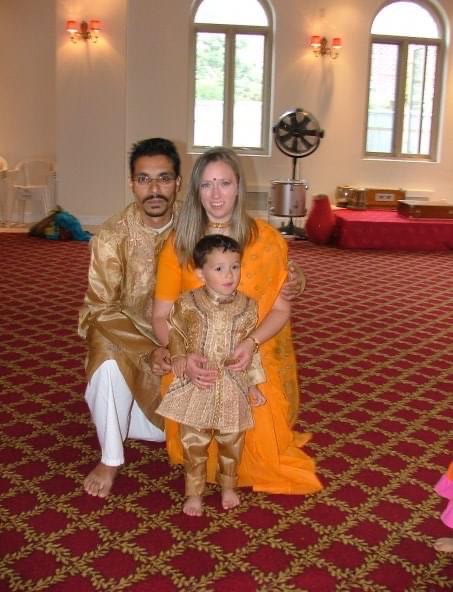
Matt, imitating a Gujarati accent chuckles as he says, “I’ve been married for 12 years and been to India more than 10 times … I’m an ABCD (American Born Confused Desi, that second generation South Asians are often referred to) now!”
We all are aware that tensions can run high at most weddings, add to that an intercultural one, and it can cause a bad case of nerves. “I was super nervous about meeting her parents when we flew to get married in India,” says Matt, adding, “I had never met her parents before and I had heard all the stereotypes that Indian people only marry other Indian people and within that Gujarati people only marry other Gujarati people, so I was worried naturally. But about 20 people picked us up at the airport and they were the nicest people. I loved the whole family aspect of it. The family was always hanging out together. They’re all super close. That’s why in India you call your cousins — your brother and sister. And my family was never like that. We have divorce in our family and stuff. Just seeing the way it was in India was pretty nice.” And that helped soothe the initial jitters. Matt adds laughing, “I didn’t think her parents knew about us… but at the wedding her dad joked that ‘now you both can officially live together!’”
Now How Do I Greet Her?
Says Kristina laughing, “One thing I remember from our wedding is that we were on the stage waiting to meet the guests one by one. And as they came, they either hugged my husband or folded their hands together in a namaste … but they had no clue what to do with me. I kept watching them think ‘now how do I greet her?’ That was pretty funny.”
Another aspect of intercultural marriages that can cause some strife is bhasha or language. “Shamefully, I don’t know more than maybe 20-30 Bengali words. I pick up a bit more when I spend extended periods of time with Srabani’s family, but I always tend to forget the words when those visits are over,” says Dave.
Scott adds, “I picked up several words on my visits to India but were typically words used when shopping and visiting friends and family. Finally, I learnt a handful more from trying to translate conversations with my wife’s family so I could keep up with important gossip, “he jokes.
Daryl, always the jokester, adds, “My wife takes sadistic glee in constantly pointing out that despite her efforts to school me, after over almost a half-decade of marriage, I only know a handful of words and phrases. She is both amused and annoyed that of all the words and phrases she has tried to teach me — the ones I most remember are the one’s describing a nagging wife or having a bowel movement,” he says, cracking up.
Kristina says, “My husband has so many friends from different parts of India and he knows like seven of those languages. So, he speaks with each of them in a different language. Now if he spoke with all of them in the same language and I was constantly hearing the same language, I may pick it up better. When we get together with our Indian friends, for the first half and hour or so everyone speaks English, and then they slowly go back to their own language.”
The Kids are Alright
As for the next generation, one wonders how hard it is to raise interracial kids. Says Scott, “We wanted our kids to know both cultures. We both made a big effort to use Bengali words and speak Bengali with our kids, but being in a predominantly English-speaking environment, it was hard to do. The default language is English now. Both our kids gravitate to a more American lifestyle. This isn’t too shocking as we live in the suburbs, and even our neighbors’ kids from other cultures, tend to do the same.” Scott admits it is hard though, “My younger one has experienced a few situations where boys have made snide remarks and taunted him, but we have taught him to stand strong.”
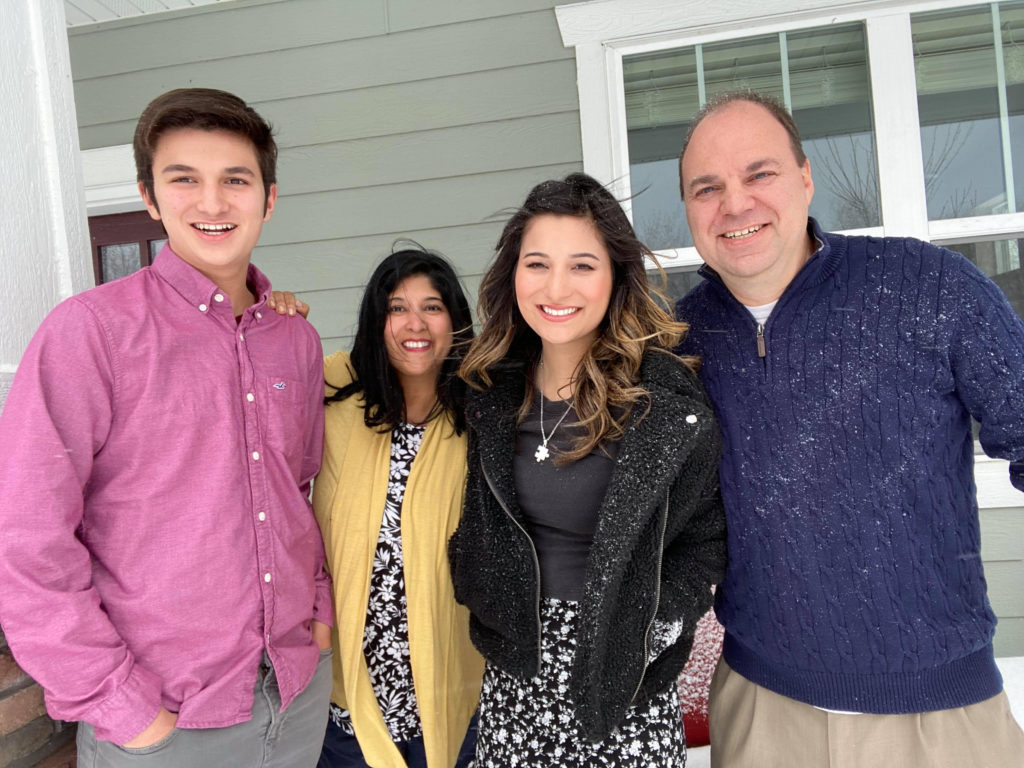
He continues, “We have always told our kids that it’s better to try and find belonging than the need to fit in. This is a struggle for all kids I think, but more so interracial. My kids have friends from lots of backgrounds. No one can place what their nationalities are. They have been mistaken for Hispanic, South America even Middle Eastern!”
“We are open-minded and we will tell the kids to choose the religion they want when they are old enough to understand what religion is,” says Kristina, who celebrates all the Catholic and Muslim holidays — Easter, Christmas and Eid. “That’s why our friends love to come to our house for these holidays!”
Says Kelli, “We have encouraged our son Braeden, to explore and learn about both cultures. He’s been learning Bengali. He can understand it well, but doesn’t always speak it. When we visit my family, we take him to church so he can experience that. We also go as a family to celebrate Durga Puja with the Bengali community here in Pennsylvania. We want him to know everything.”
Tom mentions, “We decided to wait to have children to give us time to acclimate. However, when the kids came, there was a period when she craved cultural identity. She didn’t want the kids to go through life without some foundation. And to do all of those things together — identify as American, as Indian and as Parsi — is difficult. You see it often where immigrant parents remain very culturally identified with their home country and not where they are, and these kids become misfits in both. And we did realize that early on and didn’t want that to happen to our kids. We wanted them to have more than an American identity. It’s okay to be American, not the obnoxious American, which I have never been.”
So, what advice do our couples have to those contemplating an intercultural union? “Be open minded,” says Dave. “It’s a big world and people think and do things differently everywhere, which isn’t a bad thing at all — just stay open to learning how other cultures ‘click’.”
He continues to add, “Also be willing to change and be respectful; there’s no room in an intercultural relationship for cultural snobbery. Ultimately, it’s a really enriching experience, one just has to be open to being enriched!”
Says Kelli, “The thing in an interracial marriage is to be open minded. Don’t be stubborn. Everybody’s different. That doesn’t make them wrong. Learn about the different cultures. The more you learn about why they do things the way they do it, helps you understand them better.’
Daryl adds, “The key words in any interracial marriage are acceptance, balance and compromise.”
Great advice for all to heed.
And because Indian prejudices and attitudes are largely based on what other people in the community think, and are generational, there is hope that with the coming generations educating their families about the values in other cultures, these attitudes can change, bringing with it a new day!
Anu Ghosh immigrated to the U.S. from India in 1999. Back in India she was a journalist for the Times of India in Pune for 8 years and a graduate from the Symbiosis Institute of Journalism and Communication. In the U.S., she obtained her Masters and PhD. in Communications from The Ohio State University. Go Buckeyes! She has been involved in education for the last 15 years, as a professor at Oglethorpe University and then Georgia State University. She currently teaches Special Education at Oak Grove Elementary. She is also a mom to two precocious girls ages 11 and 6.


